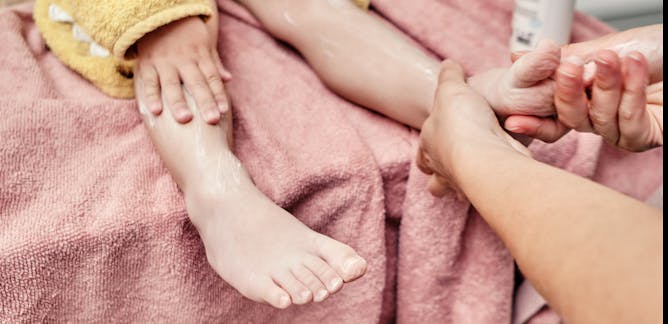
Articles on Eczema
Displaying 1 - 20 of 26 articles

From synthetic fabrics to car exhaust to wildfires, exposure to environmental pollutants push the skin microbiome to adapt in ways that reduce its ability to protect the skin.

Itch-sensing neurons in your skin are intertwined with your immune cells. Counterintuitively, the molecule that connects them triggers responses that both worsen and improve skin conditions.

When eczema is very active, the skin literally bubbles with fluid and can begin to weep. Bacteria love to colonise and infect this type of eczema.

Patients and some doctors have an inflated sense of the risks of low-to-moderate strength cortisone cream and might not use enough to be effective.

Although most skin conditions aren’t dangerous, they can be painful, irritating and frustrating to deal with.

Many doctors currently diagnose skin conditions by eye. Advances in molecular testing could lead to more precise and accurate diagnoses for ambiguous rashes and skin lesions.

In Summer, you may need to be extra sun smart if you’re swallowing certain medications or putting them on your skin.

Up to 35% of people misdiagnose themselves (or their children) with a food intolerance or allergy. It’s time to set the record straight.

Can a naturally occurring skin microbe help millions who suffer from eczema?

If you looked at the ingredient list on your body wash, shampoo, toothpaste and cleaning products, you’d probably find most contain sodium lauryl sulfate (SLS). It is a known irritant to human skin.

Common emollients used to treat skin conditions are a hidden fire risk in most homes.

Can your kids be too clean? Increases in allergies suggest so. But how much dirt is too much? A pediatric allergist explains the fascinating reasons the immune system needs dirt for training.

Avoiding certain foods risks malnutrition.

With food allergies on the rise, it’s important to understand the role the skin plays in protecting or exposing us to reactions.

When it comes to looking after your skin, some stubborn “facts” endure, so a dermatologist sets the record straight.

In this clinical trial, the first of its kind, physicians explore whether directly applying a ‘good’ strain of bacteria to the skin can heal eczema

Reports that a study found baby wipes to be a contributor to childhood allergies were plain wrong. The study didn’t test baby wipes, and was done in mice.

Here’s a list of the most common rashes and what you need to look for.

Many of us cover our faces with foundation and other beauty products every day. Here’s what we know about whether they are doing us damage.

Seawater has been used to treat skin problems, sinuses and mental health issues for centuries. And the evidence largely stacks up.





